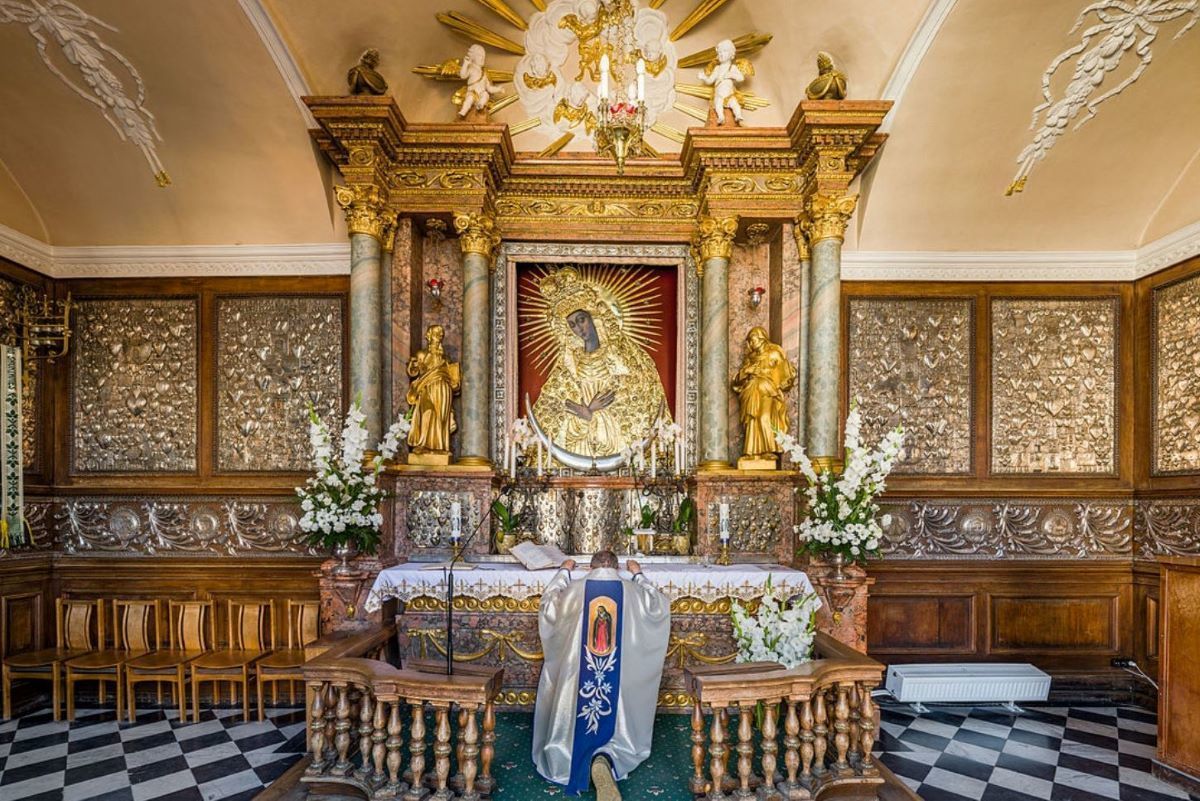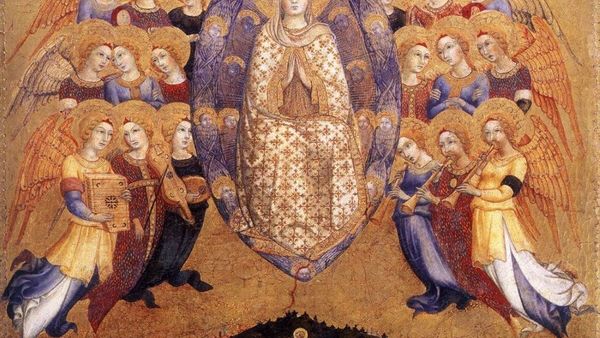“Devotion to Mary is intrinsic to Christian worship,” so says the Catechism (§976), quoting Pope Paul VI. Perhaps, though, one would not guess this from the number of times one hears a homily on the subject of the Blessed Mother, or sings a Marian hymn at Mass. Marian hymns are quarantined to the two Marian feast days designated as holy days of obligation in the United States, and homilies on those days treat the dogmas being celebrated rather mechanically and awkwardly if at all.
They often remind me of the kind of conversation we generally liberal-leaning university faculty members have if confronted with potential benefactors who persist in bringing up topics, like patriotism or miracles, which are anything but intrinsic to polite conversation on campus. Not only does Marian piety not seem “intrinsic to Christian worship,” but devotion to Mary and any discussion of it seems increasingly adventitious to Christian worship, and in general offensive to pious educated middle-class ears under a certain age.
Is the solution more intensive catechesis on the subject of Mary? The short answer to that question is “Yes,” but this answer is deceiving. Language that encodes the intrinsic character of Marian devotion to Christian worship is restricted because it carries with it a whole theological framework that has itself been left behind. The whole framework in which it made sense to sing, “Hail Holy Queen Enthroned Above . . . Hail Mother of Mercy and of Love,” despite the best efforts of Whoopie Goldberg, has itself been left behind.
That is the reason for the awkward feeling on the Feasts of the Immaculate Conception and the Assumption. But this is what makes either one of these topics splendid places to begin a renewed Catholic dogmatics, because in order to make these dogmas make sense to people, the whole system in which they do fit and make sense has to be recovered, renewed, and rearticulated. In fact, the catechetical problem is only a reflection of this larger theological problem of recovery of a framework, and my intention in this brief discussion is to illustrate the theological problem by looking at the catechetical problem.
How does one respond to someone who asks, why should we sing, “Hail Holy Queen, Mother of Mercy?” And what good is it to “send up our sighs” to her? One can answer, “Because we would like her to intercede for us with her divine Son.” But this answer on its own is never very satisfying to the questioner, because it seems to beg more questions than it answers.
We seem to be saying that Mary is like the chief lobbyist in the heavenly Washington D.C. And we all know that God does not care who wins Notre Dame football games (but his Mother does) and so Irish fans know enough to say Hail Mary’s at the appropriate moments in a game. But this kind of prayer, thematized in this way, can hardly seem “instrinsic to Christian worship.” Why then do we persist in the invocation of Mary, and how is it anything but idolatry? That is, how can it be “intrinsic” to Christian worship without competing with God?
One way to answer the question is to adopt Elizabeth Johnson’s strategy, namely, that phrases and titles such as “Mother of Mercy” do actually belong to God. They have been displaced from God to Mary because the constraints placed on the Christian imagination by patriarchal cultures did not permit God to be addressed in feminine terms. They should therefore be allowed to “migrate” back to God:
The classical Marian antiphon Salve Regina salutes Mary as “mother of mercy, our life, our sweetness and our hope”; to her the poor banished children of Eve send up their sighs and pray: “turn then most gracious advocate, thine eyes of mercy toward us.” In the end Mary is asked to show us Jesus, but the form of the prayer itself casts her in the life-giving role of the merciful one. Returning this language to God to whom it properly belongs enables us to name God’s own self as essentially and unfathomably merciful (Truly Our Sister, 88).
Once we stop using Mary as a “coverup for defective notions of God” (86); once what “has been guarded in her symbolism can find its rightful place in the living God again” (91), so that “God [can] have her own maternal face,” Mary, or rather “Miriam the Galilean woman” is free to “rejoin the community of disciples” (92). She is free to become “Spirit-filled friend of God and prophet within the circle of disciples,” “sister to all who partner with the Spirit in the struggle for the coming of the reign of God” (104).
But this strategy seems to place devotion to Mary even farther away from anything “intrinsic” to Christian worship. Mary is reduced to an exemplary “model” for Christians to imitate and from whom to draw inspiration. But this translation, “model,” does not seem to carry the full import of the Latin word typus used in Lumen Gentium to describe Mary’s status. Certainly the title “friend of God” seems quite a bit less intrinsically relevant to Christian doctrine than the title “Mother of God” of the Council of Ephesus, which John of Damascus famously said contains all of Christian doctrine, implicitly, in one formula. And does this low Mariology actually buy us a God who is as “essentially and unfathomably merciful” as expected?
We can see how the problem concatenates. A low Mariology such as this can only exist as a function of an inadequate, low Christology. A low Mariology is something like a low Christology squared. In his book, Does God Suffer, Thomas Weinandy defends the impassibility of the divine nature in order to uphold the mystery that in Jesus Christ, “the impassible suffered” (202, paraphrasing Cyril of Alexandria). Weinandy’s idea is that the defense of the impassibility of the divine nature does not lessen the impact of God’s suffering in Christ, but preserves the very possibility of any true suffering for God.
Even if one did allow the Son of God to suffer in his divine nature, this would negate the very thing one wanted to preserve and cultivate. For if the Son of God experienced suffering in his divine nature, he would no longer be experiencing human suffering in an authentic and genuine human manner, but instead he would be experiencing “human suffering” in a divine manner which would then be neither genuinely nor authentically human. If the Son of God experienced suffering in his divine nature, then it would be God suffering as God in a man.
He continues thus,
This is the marvelous truth of the Incarnation. God from all eternity may have known, within his divine knowledge, what it is like for human beings to suffer and die, and he may have known this perfectly and comprehensively. But until the Son of God actually became man and existed as a man, God, who is impassible in himself, never experienced and knew suffering and death as man in a human manner.
Weinandy then reaches the following conclusion:
In an unqualified manner one can say that, as man, the Son of God had experiences he never had before because he never existed as man before—not the least of which are suffering and death. This is what humankind is crying out to hear, not that God experiences, in a divine manner, our anguish and suffering in the midst of a sinful and depraved world, but that he actually experienced and knew first hand, as one of us—as a man—human anguish and suffering within a sinful and depraved world (204; 206).
We could add to Weinandy’s list of new things that God experiences, having a mother. I would submit that this is part of what humanity is “crying out to hear,” namely, that God, the self-originate, knows now what it is like, as a human being, to have a mother, and that this mother is really a mother.
Humanity is crying out to hear that the one we venerate as “mother” really is someone who truly carried her historical child in her historical womb and watched him historically suffer. To let the maternal imagery “migrate” from Mary back to God, as though the imagery were static and self-evident and meant the same thing no matter “where” it was attached, essentially mythologizes this imagery, and with it, the one we call Mother. We can no longer be assured that “our Mother” knows from experience how real mothers suffer “within a sinful and depraved world.”
But that is what gives Marian devotion its attraction and its power, what those who ask the catechetical question are looking for. As “Mother of God” and not merely “friend of God,” Mary is the Mother of the Incarnate Word, not simply the Mother of Jesus. She is therefore,
Acknowledged and honored as being truly the Mother of God and of the redeemer. . . . She is “clearly the mother of the members of Christ” . . . since she has by her charity joined in bringing about the birth of believers in the Church, who are members of its head (CCC §963, citing LG §53, itself citing Augustine).
Mary’s role as “Mother of God” cannot be reduced simply to a physical event, leaving her uniquely, though only, a model for the rest of us because of the Spirit filled way in which she accomplished the role which the unique physical event gave rise to.
In Mary’s motherhood, the physical and the spiritual completely coincide. Her “burning charity,” in assenting to the angel’s request, is the human love in which we were all born as members of her Son; it makes her a “mother to us in the order of grace” (CCC §968, citing LG §61). It is in this sense that Mary is “Mother of Mercy,” mother of the mercy that God has on all of us as members of Christ.
So, to “migrate” this title back to God directly is actually to miss the depth of the mercy of God, which consists precisely in willing to have a mother as we have a mother, and in that act of mercy to give us a mother too. God does not rape the Blessed Virgin, but asks for her consent to bearing the Savior, and in giving her consent by God’s grace, she becomes not less herself but more, someone whose very physical motherhood is a perfect expression of love.
Is it divine mercy that we find in Mary? Yes, but as a gift that formed her into the trusting and courageous person who followed Jesus to the Cross, and so follows all of us, who are conformed to the Paschal mystery by Baptism, to the Cross. Invoking Mary as “Mother of Mercy” is truly to praise God as “essentially and unfathomably merciful.” Devotion to Mary is thus “intrinsic” to Christian worship, for without it the true depth of the mercy of God is invisible to us.
Oddly enough, the only way we know that God, the true God, knows by experience what a Mother suffers is if Mary is allowed to remain the completely human Mother of God and to receive invocation under that title. For, as “Mother of God,” she is completely conformed and configured to the burning love of Christ, to the Paschal Mystery. She is the exemplary realization of the Church, its “type,” the image of conformation to Christ, the mother of the “whole Christ,” Head and members. In Jesus as a human being, God’s human experiences are, in a way, limited. He does not know by experience what it is like to be a mother. He has that experience in Christ through those members of Christ conformed to him in perfection. In a preeminent way this means Mary.
Invoking Mary under the title of “Mother of God” means invoking God’s solidarity with humanity in the Incarnation, not in the abstract but in its work in a real human person, and that means invoking the “new experience” God has in this real human person, configured as a member of his Son, really, as his Son. To invoke God directly as Mother, leaving Mary behind, is to invoke a “motherhood” re-mythologized, leaving us with no basis for believing that God really knows our situation, really knows what it feels like to bear a child in this sinful and depraved world and see him, or her, suffer death before you. It is an impoverished, or at least irrelevant, motherhood.
So, how would I reply to someone who did not understand why we invoke the Blessed Mother in prayer? I would have to start at the end of the whole train of reflection just offered, namely, at the Church, at the communion of saints. Usually the questioner has no trouble with the intercession of Christ at the right hand of the Father, since it is both scriptural and creedal.
But why not pray directly to God, even here? Presumably because, the inquirer will agree, the prayer of Christ is the prayer most perfectly conformed to the Spirit, most self-less, the presentation to the Father of the Paschal Mystery, a prayer of perfect love and obedience. But the saints, including preeminently Mary, are those who are conformed to Christ. The Church is not simply a cosmic version of the United States of America, formed because “We the people” decided to come together to perform certain actions in common. The Church is not the “people of God” in that sense, but is the Body of members conformed to Christ, those who participate in his high priestly prayer because they are him. This is not the international association of heavenly lobbyists.
We recommend our prayers to the saints, and to Mary in particular, because most of them, if prayed as they should be prayed, would break our hearts. We would have to give as much or more than we are asking. As much as we would, and should, desperately desire that one of our children, for instance, live and not die, we have to remember that recovery from illness is only a sign of salvation, and not salvation itself.
What to do at such a time? Recommend my prayer to the saints. Which saint? Perhaps, if you are a father, to Franz Jaegerstadter, who was the father of a family and yet made the terrible choice of martyrdom, knowing that loving his children did not mean sparing them the example of his father’s faithful witness as a Christian. Invoking the servant of God is praising and thanking God, who deigned in Christ to know this human fatherly suffering by experience, in solidarity, in one of his perfected members. It is, in the end, to invoke the love of God.
But in this situation, who better to invoke than the “Mother of Mercy,” the one in whom, as a perfected member of His Son and the typus of all the whole body of perfected members, God experienced what it was like to see one’s very own child, bone of my bones and flesh of my flesh, die before me. Invoking Mary as “Mother of Mercy” invokes the depth of God’s mercy, not because Mary is divine, but because in her absolutely and fully human motherly love, a real mother’s love, we have known the depths of God’s solidarity with us.
God is not stingy, restricting his solidarity only to the specific historical sufferings of Christ, but extends that solidarity to those who, as members of the one Body, “make up for what is lacking in the sufferings of Christ.” It is thus that in the cult of Mary, and by derivation in the cult of all those whose “type” she is, God is most truly and most deeply praised. We can see that the cult is “intrinsic to” Christian worship, without itself being worship of Mary.
So—to solve this simple catechetical problem concerning Mary, one must in the end treat Christology, Ecclesiology, and Eschatology. It is a kind of parable for explaining why beginning with Mary is the beginning of a whole renewed, refreshed, and rearticulated dogmatic, and not simply an interesting side issue undertaken for its shock value or because it is so obviously in disrepair. To get the doctrine of Mary right implies and requires a renewal that gets the rest of it right, in a way that people of today can hear, and in a way that will, on the other end of the project, proclaim the mercy and the solidarity of God to an age that is desperate to hear it.


